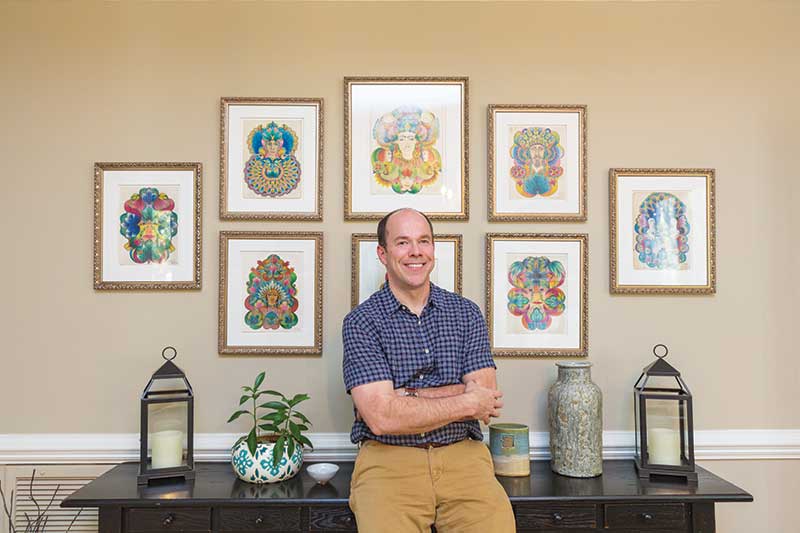Growing up, Christian Daniel collected things like stamps, coins and rocks.
His grandfather ran a Coca-Cola bottling company, and Daniel soon began collecting vintage advertising. Then he started collecting folk art, such as hand-painted wooden signs for businesses from the late 1800s or utilitarian items made beautiful by the pride of the maker.
Today, the Wilmington resident has a large collection of art, including Minnie Evans’ work, “one of the blue chip, better, top-tier folk artists,” he said.
Evans, who worked in different media starting with crayon and wax, came to Wilmington with her mother in 1893, when she was a year old. Later, she created pieces and sold them at Airlie Gardens, where she was the gatekeeper. Pieces she gave away or sold for less than a dollar are now selling for thousands of dollars, Daniel said.
Art as an investment can be a good idea, Daniel said, if one has already put aside funds, educated themselves about art and wants to give it a try.
“I would never recommend that anybody invest in art as all your eggs in one basket,” he said.
It’s a tangible asset, he said, but be wary. The markets could be volatile. Art collectors who collect some types of furniture, for instance, have experienced value declines of up to 70 percent in the past decade.
Unlike some other types of investments, Daniel said, when the value of a particular artist’s work drops, it rarely recovers.
Another factor to consider is the potential for tax implications – sales of collectibles can be subject to a capital gains tax of 28 percent.
Amy Grant, owner of Art in Bloom Gallery in Wilmington, concurs that return on investment for collectible art is unpredictable.
“The commercial art world is constantly changing and shaped by forces related to the economy, academic points of view, museums, fashion, media and entertainment, culture, politics and other spheres of influence,” she cautions.
Grant said she often speaks with people who collect fine art for investments and has learned that people who make good decisions use multiple objective and subjective approaches.
Objective evaluation of art includes provenance (record of ownership over time), authenticity, originality, condition, rarity and the artist’s biography and place in history.
Subjective evaluation of art includes how people feel about composition; technique; skill such as use of light, shadow and perspective; style such as realistic or abstract; and other qualities.
Grant said examples of when bad art-buying decisions might be made include when the buyer is pressured to buy the art by a certain deadline, either by the implied threat that someone else will buy it; buying art without doing the research; not carefully examining the condition of the art; and not being aware of the difference between a reproduction and original work.
And all investments require care. Grant said it’s important to take care of the art in a climate-controlled environment.
“Depending on the economy and other factors, the art could have a different valuation every two, three, five, 10, 20 years and beyond,” Grant says. “As with the stock market, you cannot time the art market. However, you can continue to monitor the history of sales and/or the artist and the evolution of the art.”
Consultant Ian Taplin said the current trend seems to be contemporary art as the most popular. This can be related to which artists larger galleries have promoted. Taplin is a consultant on the art market and luxury goods and professor of sociology at Wake Forest University. He is writing a book on luxury goods (focusing on the art market, fashion and wine) that will be published by Routledge next year.
“The way the [art] market is structured, some people buy big ticket items and then store them for several years prior to reselling,” he said. “They tend to gauge what the market is like and time their sale accordingly. Prices could conceivably double in that time period, which is a huge return. Others simply look for above average returns as part of a balance portfolio that includes art. You have to remember that art has no intrinsic value other than what the market sets.”
Collecting art for beauty uses the same principals as collecting for investment.
Hathia and Andy Hayes, interested in art since early in their marriage, celebrated their graduation from the University of Georgia in 1971 with the purchase of several pieces by Steffen Thomas. It was their first major art purchase and was guided by their personal taste and suggestions made by the artist. Living with the Steffen Thomas sculpture and paintings began a lifetime of studying, researching and learning from artists.
“There is much to learn about art, artists and the purchasing of art,” Hathia Hayes said. “Talking and observing artists at work and in workshops, speaking with art dealers, gallery owners, other ‘collectors,’ studying works of art in museums and talking about what is being learned … all of these events inform and influence potential purchases. Living with art day after day, if one stops to give it a study, increases the opportunity to grow taste and preference.”
Taplin suggests: “Buy what you like. You might hope it improves with value but since most of us have to live with it, you might as well like looking at it.”




